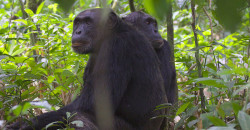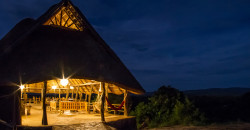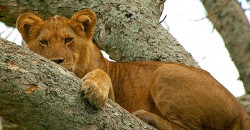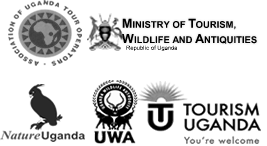Uganda Parks & Game Reserves
Queen Elizabeth National Park
Queen Elizabeth national park was opened by Queen Elizabeth of England in 1954, and this park is located in the Southwestern part of Uganda shared by districts of Kasese, Bushenyi and Rukungiri. The headquarters of Queen Elizabeth National Park in Mweya can be reached through Fort portal to Kasese about 440 kilometers or Mbarara just about 425 kilometers and both way can be travelled between 6-7 hours. For those who want to travel by air a private charter flight can be arranged for you to Kasese air strip where a transfer to the park can be made.
Murchison Falls National Park
This is the largest of the ten national parks Uganda has and it covers an area of about 3,893 sq. kilometers. From Kampala to Murchison Falls it takes about 5-6 hours through Luweero via Nakasongola and Masindi District or through Kiboga via Hoima and Masindi. The park is one of the most spectacular parks in all of Africa. Its well known for its rolling savannah, wetland, as well as tropical forest and the stunning falls, the park has plenty of flora and fauna with over 70 mammal species, over 445 different species of birds, 250 species of butterflies, 10 of primate species and more than 450 species of plant
Bwindi Impenetrable Forest National Park
This park is positioned in the Southwestern part of Uganda and covers an area of about 331square kilometers. It takes 8-10 hours to reach the park through Mbarara, Kabale and Kanungu to Buhoma. The park has both lowland and montane rainforest with thick bushes of herbs, vines and vegetation, making the Park looks impenetrable. The forest is a home to many rare species and the most common one is the few remaining mountain gorillas in the world. More than a half of the world’s population of mountain gorillas is found in Bwindi impenetrable forest about 325 out of 770 individuals.
Kibale Forest National Park
Kibale forest National Park is located in the Western part of Uganda in the district of Kamwenge about 450 kilometers from the capital city Kampala and can be driven in just about 5-6 hours. It is one of the newly created Parks having been a forest reserve and it has been a national park since 1995. The park covers 795km2 and is bordering to the northern end of Queen Elizabeth National Park. Most of the Southwest part of Kibale National Park is a mix of grassland and wetland with interesting plant life, while North and Southeast part are mainly tropical forest with more than 345 trees species recorded in the area over (27% of country’s total).
Lake Mburo National Park
Lake Mburo National Park is located in Southwestern part of Uganda between the towns of Masaka and Mbarara, and it is about 260 Kilometers from Kampala Uganda’s capital and largest city and can be traveled in 3-4 hrs. The park covers over 260sqkm and it has attractive rolling hills woodlands, wetlands and open grassy valleys.
Kidepo Valley National Park
Kidepo valley National Park is regarded as the most remote National Park in Uganda as it is located in the far Northeastern corner of Uganda along the boarders with Sudan and Kenya. It has been a National Park since 1954 and it covers an area of about 1,442sqkm. It is about12hours drive or more in good weather from Kampala, via Mbale, Soroti and Moroto which is about 700-800 kilometers. A 4WD is recommended and it is advised to schedule a two days journey in case you are travelling by road, or it can be accessed by air and chatter flights are readily available daily. The Park is regarded as a fabulous national park because of its mountain scenery and savannah plains.
Mgahinga Gorilla National Park
Uganda’s smallest yet most scenic National Park is situated in the extreme South-Western corner of the country, forming part of a large conservation area that straddles political boundaries to include Parc des Volcano in Rwanda and Parc de Virungas in the Democratic Republic of Congo. Three extinct volcanoes, part of the spectacular Virunga range, lie within the boundaries of the Ugandan portion of this biologically rich area, and provide a striking backdrop to Mgahinga’s gorgeous scenery. Mountain gorillas form the main attraction of the Park, and are the reason for its existence, thought the habituated group frequently crosses the border to Rwanda.
Mount Elgon National Park
Mountain Elgon is an extinct volcano that first erupted more than 24 million years ago. With the largest surface area of any extinct Volcano in the world (50km by 80km), Mount Elgon is the fourth highest mountain in East Africa, with the second highest peak in Uganda (Wagagai peak, 4321 m). It contains the largest intact caldera, a collapsed crater covering over 40kms at the top of the mountain, surrounded by a series of rugged peaks. While ascending Mount Elgon’s enchanting slopes you will meet four-distinct forest types: the lush montane forest where you will find the Elgon peak, mixed bamboo belt, the fascinating
Mt. Rwenzori National Park
The park is located in the western part of Uganda on the border of Uganda and the Democratic Republic of Congo. The park has an area of 998 sq km and was named after the famous Rwenzori Mountains which is also referred to as the legendary “Mountains of the Moon.” Rwenzori Mountain is one of Africa’s tallest mountain range with an elevation of 5,109m. The Rwenzori range has 6 major peaks which include, Mt Stanley (5,109m), Mt Speke (4,890m) Mt Baker (4,843m), Mt Emin (4,798m), Mt Gessi (4,715m) and Mt Luigi di Savoia (4,627m). The highest peak is the Mt Stanley complex and is called Margherita peak
Semliki Forest National Park
Semliki National Park is one of Uganda’s newest National Parks. It is located in the extreme west of Uganda in Bundibugyo. It lies along the Uganda and Democratic Republic of Congo (DRC) border within the western arm of the Rift valley. The park covers an area of 220 sq km and covers an eastern extension of the vast Ituri Forest. It forms part of the forest continuum during the climatic upheavals of the Pleistocene, and is one of the richest areas for both flora and fauna in Africa most especially birds.
Budongo Forest Reserve
Budongo forest reserve is situated in the North-western part of Uganda and its just 3 hours drive from Kampala via Masindi District. The reserve covers an area of about 825sq kilometers of where by only 53% is forest and the remaining part is grassland forest. It has been a forest reserve since 1932. The reserve lies in the southern extension of Murchison falls National Park, which is considered the largest national park Uganda has covering over 3,840sqkm.
Semliki Wildlife Reserve
Semliki valley wildlife reserve is the oldest among other reserves in Uganda formally known as the Toro Game Reserve and it was named a Reserve in 1932. It is a 545 kilometers squared sanctuary located in Western Uganda to the northeast of the Bundibugyo road extending to Ntoroko on the southern shores of Lake Albert. The leading vegetation type is open acacia-combretum woodland and grassy savanna , mixed together with patches of borassus palm forest, significant belts of riparian woodland along the main water path as well as some extensive swamps towards Lake Albert. Semliki is mainly of interest to birdwatchers.
Katonga Wildlife Reserve
Katongo wildlife reserve is located in the districts of Ibanda and Kamwenge in the western Uganda along the banks of River Katonga. It covers an area of about 211sq km. It is about 200kms which is just about 4-41/2 hour’s drive from Kampala up to the reserve. The wildlife reserve was established in 1998 and is a recent addition to Uganda’s list of protected wildlife areas. The reserve can best explored by canoe or by foot, it is a home to over 40 species of mammals and over 150 species of birds are recorded in the area. Many of these species of animals, birds and plants in the reserve are rare to the reserve’s wetland environment.
Mabira Forest
Mabira forest is located in Buyikwe District between Lugazi and Jinja just about 54 km (1 hour) from Kampala up to the forest reserve headquarters. It has been protected as a reserve since 1932. It is covering an area of about 306 square kilometers and it’s regarded as one of the last remaining rain forest and biggest in central Uganda. It is a home to very many primate species like the red tailed monkeys, Vertvets, grey-cheeked mangabeys; it is a home to over 315 bird species including the Cassinis hawk eagle, Grey long bill to mention but a few, 97 species of moths 218 species of butterflies, 312 species of trees among others species.
Kalinzu Forest Reserve
This forest reserve is located in Bushenyi district in the Southwestern part of Uganda near Queen Elizabeth National Park and the Maramagambo forest. It is approximately 375 kilometers which is just about 6 hours drive up to the reserve headquarters. The forest lies on an average altitude of about 1400m above sea level. The reserve is known for its 414 species of trees and shrubs including prunus African Ficus and Parinari among others. The forest is also famous for its six different primate species that include chimpanzee, black and white colobus monkeys, blue monkeys, L’hoest guenon, vervet monkeys, and baboon.
Pian Upe Wildlife Reserve
Pian Upe wildlife reserve is a conservation area in the Karamoja sub region of northeastern Uganda and it’s regarded as the second largest conservation protected area in Uganda after Murchison Falls national Park. The reserve covers an area of about 2788 square kilometers to the north of mountain Elgon and it is now under the management of mountain Elgon conversation area, it lies in a semi arid county which usually receives rainfall in April and more considerable light rainfall from June to early September although in some years the rain fall is complete. Most of the Reserve is covered by undisturbed grassland and wooded grassland









